ВУЗ: Казахская Национальная Академия Искусств им. Т. Жургенова
Категория: Книга
Дисциплина: Не указана
Добавлен: 03.02.2019
Просмотров: 21611
Скачиваний: 19
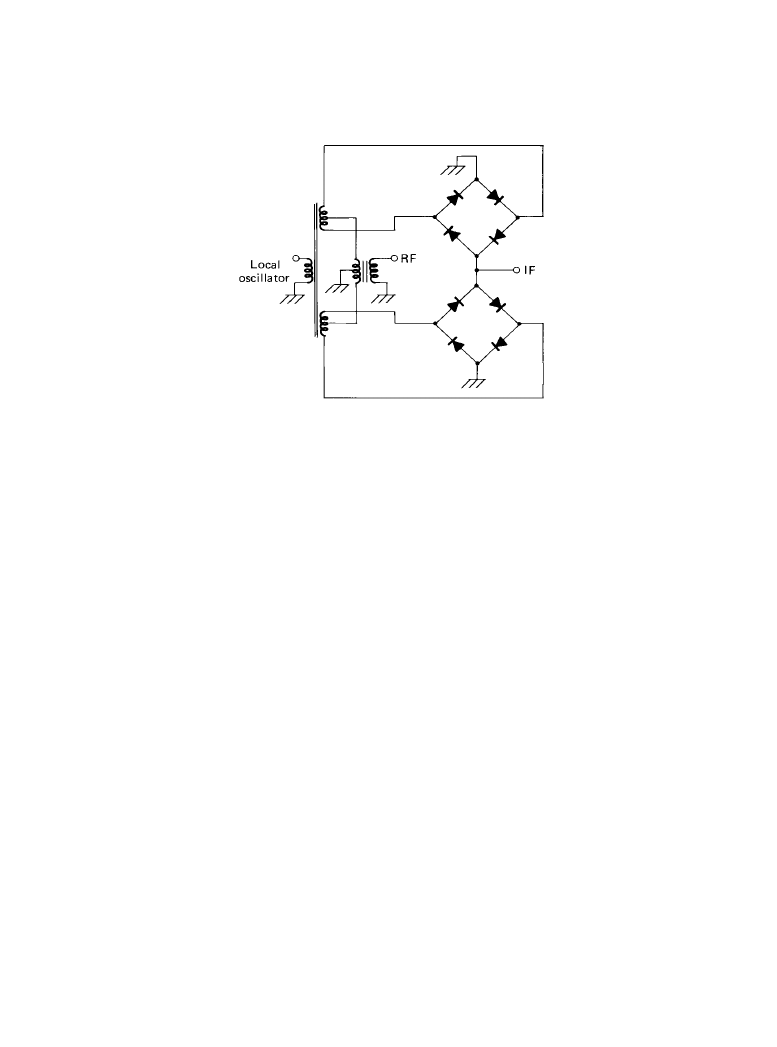
AM and FM Receivers 12-53
A single diode can be used to build a mixer. The performance of such a circuit is poor,
though, because the RF and LO frequencies (as well as their harmonics and other odd and even
mixing products) all appear at the output. As a result, a large number of spurious components are
produced that are difficult to remove. Moreover, there is no isolation of the LO and its harmonics
from the input circuit, necessitating the use of an RF amplifier to prevent oscillator radiation
from the antenna.
A better approach can be found in the double-balanced mixer, shown in Figure 12.3.10. This
circuit, with its balanced diodes and transformers, cancels even harmonics of both RF and LO
frequencies and provides isolation among the various ports. For optimum performance, careful
matching of the diodes and transformers is necessary. The manufacturing process for hot carrier
diodes has provided the tight tolerances that make them substantially better than other diode
types available for mixer applications. Passive mixers can be described as low-, medium- or
high-level mixers, depending on the diodes used and the number of diodes in the ring.
Active Mixer
The simplest type of active mixer uses a FET or bipolar transistor with the LO and RF signals
applied to the gate-source or base-emitter junction. This unbalanced mixer has the same draw-
backs as the simple diode mixer and is not used for high-performance receivers.
An improved configuration uses a dual-gate FET or cascode bipolar circuit with the LO and
RF signals applied to different gates (bases). The balanced transistor arrangement of Figure
12.3.5 can also be used as a mixer with the LO applied to the base of Q3 and the signal applied to
the bases of Q1 and/or Q5.
Active mixers can be implemented using a wide variety of devices and configurations,
depending on the specifications and cost structure of the receiver. Figure 12.3.11 shows a push-
pull balanced FET mixer. The circuit uses two dual-gate FETs in a push-pull arrangement
Figure 12.3.10
Schematic of a double-balanced passive mixer. (
From [1]. Used with permission.)
Downloaded from Digital Engineering Library @ McGraw-Hill (www.digitalengineeringlibrary.com)
Copyright © 2004 The McGraw-Hill Companies. All rights reserved.
Any use is subject to the Terms of Use as given at the website.
AM and FM Receivers
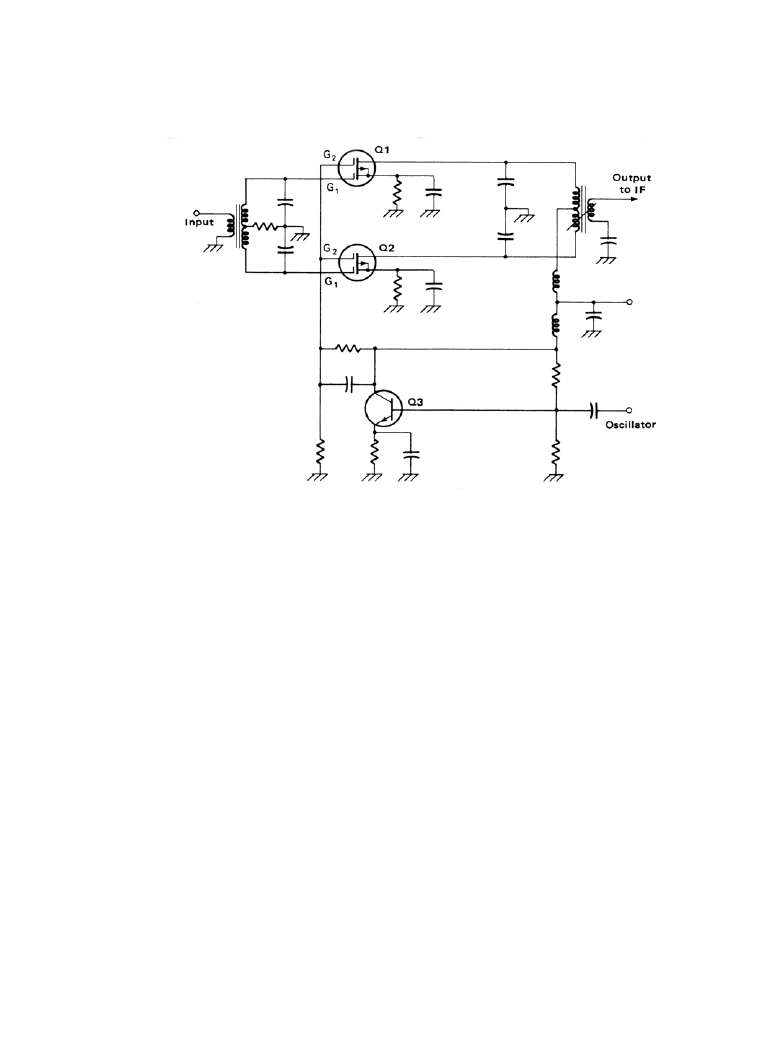
12-54 Radio Receivers
between the RF input (applied to the first gates) and the IF output. The oscillator is injected in
parallel on the second gates.
Active mixers have gain and are sensitive to mismatch conditions. If operated at high levels,
the collector or drain voltage can become so high that the base-collector or gate-drain junction
can open during a cycle and cause severe distortion. Control of the RF input by filtering out-of-
band signals and AGC are important considerations for active mixer designs. Advantages of the
active mixer include lower LO drive requirements and the possible elimination of an RF pream-
plifier stage.
12.3.3e
Local Oscillator
Most modern high-performance receivers utilize a frequency-synthesized local oscillator to gen-
erate all individual frequencies needed over the required band(s). Synthesized oscillators gener-
ally use varactor diodes for the required variable-tuning capability. This arrangement offers a
stable frequency source that is easily tunable in precise steps and is easily adapted to prepro-
grammed stations. The days of station presets based on moving electromechanical elements are,
thankfully, gone for good. The LO must meet three basic requirements:
•
Spectral purity to simplify IF filtering requirements
•
Frequency agility to facilitate rapid station selection
Figure 12.3.11
Schematic diagram of a push-pull dual gate FET balanced mixer.
Downloaded from Digital Engineering Library @ McGraw-Hill (www.digitalengineeringlibrary.com)
Copyright © 2004 The McGraw-Hill Companies. All rights reserved.
Any use is subject to the Terms of Use as given at the website.
AM and FM Receivers
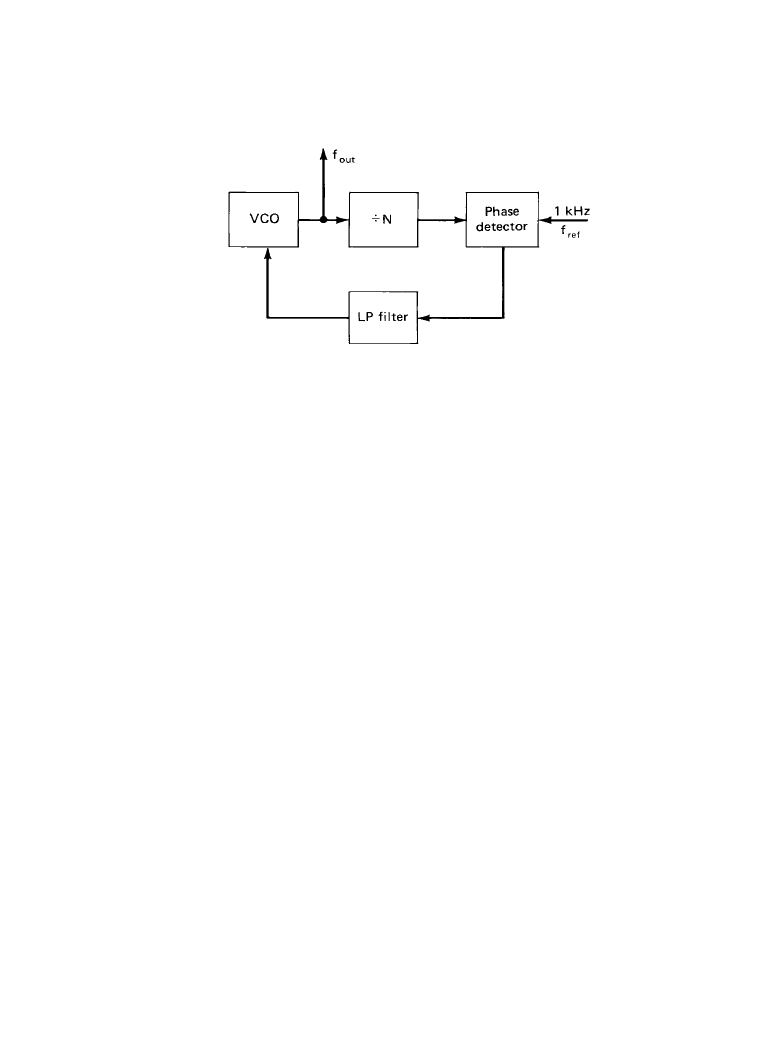
AM and FM Receivers 12-55
•
Frequency adjustment accuracy to match the center carrier frequencies of AM and FM broad-
cast stations
Synthesizers may categorized into two basic classes:
•
Direct, in which the LO output is derived from the product of multiple mixing and filtering
•
Indirect, in which the LO output is derived from a phase-locked loop that samples the direct
output to reduce spurious signals.
PLL Synthesizer
Most AM-FM receivers incorporating a frequency synthesized LO use a single-loop digital PLL
of the type shown in Figure 12.3.12. When describing frequency synthesizers mathematically, a
linearized model is generally used. Because most effects occurring in the phase detector are
highly nonlinear, however, only the so-called piecewise linear treatment allows adequate approx-
imation. The PLL is nonlinear because the phase detector is nonlinear. However, it can be accu-
rately approximated by a linear model when the loop is in lock.
Assume that the voltage-controlled oscillator (VCO) of Figure 12.3.12 is tunable over a range
of 88 to 108 MHz. The output is divided to the reference frequency in a programmable divider
stage whose output is fed to one of the inputs of the phase-frequency detector and compared with
the reference frequency (fed to the other input). The loop filter at the output of the phase detector
suppresses the reference frequency components, while also serving as an integrator. The dc con-
trol voltage output of the loop filter pulls the VCO until the divided frequency and phase equal
those of the reference. A fixed division of the frequency standard oscillator (not shown in Figure
12.3.12) produces the reference frequency of appropriate step size. The operating range of the
PLL is determined by the maximum operating frequency of the programmable divider, its divi-
sion range ratio, and the tuning range of the VCO.
There are various choices of loop filter types and response. Because the VCO by itself is an
integrator, a simple RC filter following the phase detector can be used. If the gain of the passive
loop is too low to provide adequate drift stability of the output phase (especially if a high division
ratio is used), an active amplifier may be used as an integrator. In most frequency synthesizers,
Figure 12.3.12
Block diagram of a single-loop frequency synthesizer.
Downloaded from Digital Engineering Library @ McGraw-Hill (www.digitalengineeringlibrary.com)
Copyright © 2004 The McGraw-Hill Companies. All rights reserved.
Any use is subject to the Terms of Use as given at the website.
AM and FM Receivers
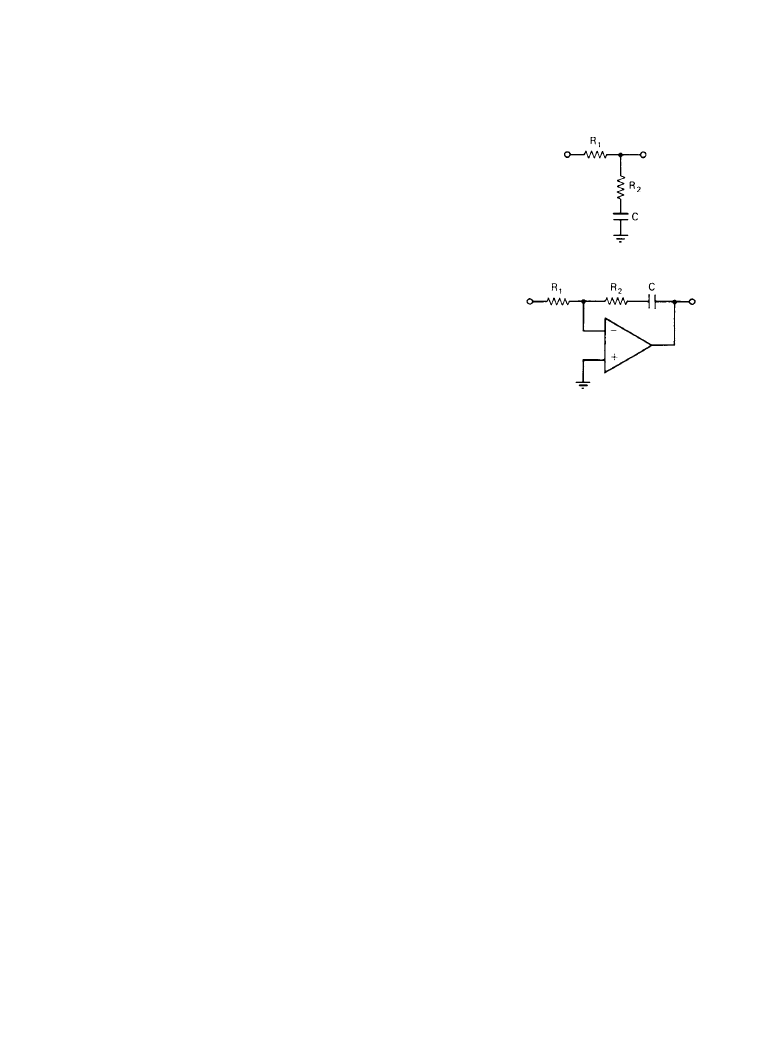
12-56 Radio Receivers
an active filter-integrator is preferred to a passive one. Figure 12.3.13 shows a passive RC filter
for the second-order loop typically used in PLL synthesizers. Figure 12.3.14 shows an active fil-
ter for the second-order loop.
Frequency Divider
Frequency dividers are commonly built using transistor-transistor logic (TTL), complementary
MOS (CMOS), and low-power emitter-coupled logic (ECL) IC technologies. Dividers come in
two common categories: synchronous counters and asynchronous counters. The frequency range
of the CMOS, depending on the process, is limited to 10 to 30 MHz. TTL operates successfully
up to 100 MHz in a ripple counter configuration. In a synchronous counter configuration, TTL is
limited to perhaps 30 MHz.
Frequency extension is possible through the use of an ECL prescaler, available in variable-
ratio and fixed-ratio configurations. The term prescaling is generally used in the sense of a pre-
divider that is nonsynchronous with the rest of the chain. Fixed-ratio prescalers are used as ripple
counters preceding a synchronous counter. A single-loop synthesizer loses resolution by the
amount of prescaling.
Figure 12.3.15 shows a block diagram of the MC12012 (Motorola) variable-ratio dual-modu-
lus presealer. Through external programming, this ECL divider can be made to divide in various
ratios. With proper clocking, the device can be considered a synchronous counter. With such a
system, it is possible to increase the maximum operating frequency to about 400 MHz without
losing resolution.
Variable-Frequency Oscillator
The LO in the receiver must be capable of being turned over a specified frequency range, offset
from the desired operating band(s) by the IF. Prior to the advent of the varactor diode and good
switching diodes, it was customary to tune an oscillator mechanically using a variable capacitor
with an air dielectric, or in some cases by moving a powdered iron core inside a coil to make a
variable inductor. Automobile radios typically used the variable-inductor method of tuning the
Figure 12.3.14
Schematic diagram of an active filter for a sec-
ond-order PLL.
Figure 12.3.13
Schematic diagram of a PLL passive RC filter.
Downloaded from Digital Engineering Library @ McGraw-Hill (www.digitalengineeringlibrary.com)
Copyright © 2004 The McGraw-Hill Companies. All rights reserved.
Any use is subject to the Terms of Use as given at the website.
AM and FM Receivers
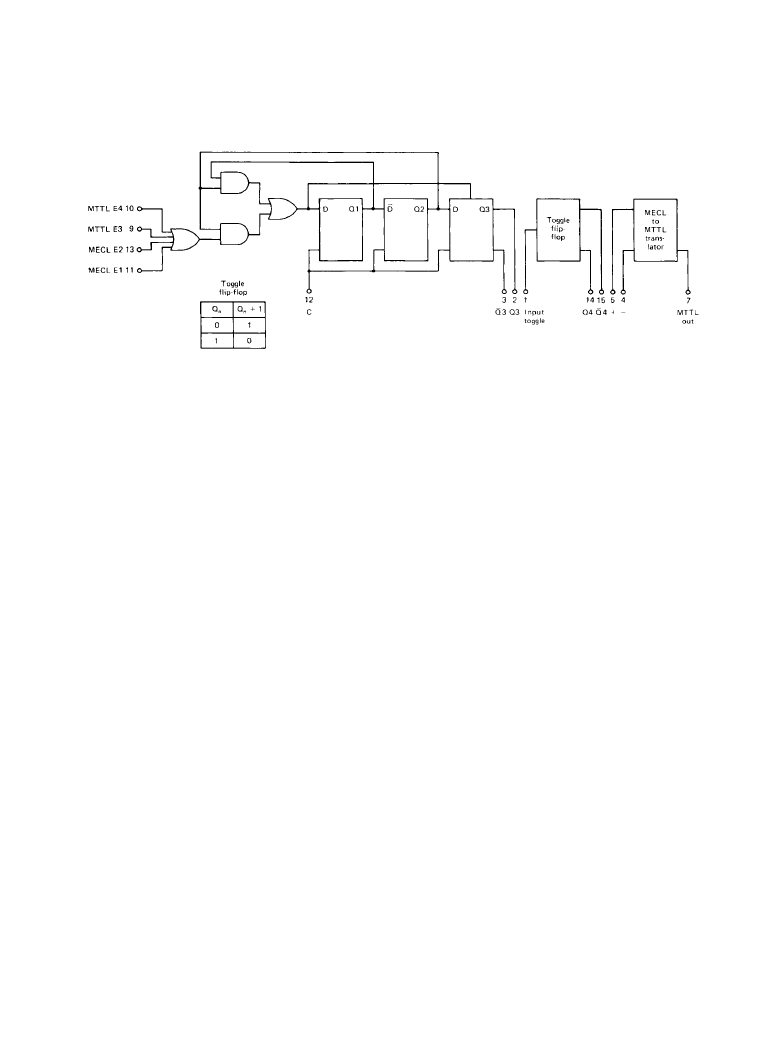
AM and FM Receivers 12-57
AM broadcast band. Figure 12.3.16 shows the classic VFO circuits commonly used in receivers.
Different configurations are used in different applications, depending on the range of tuning and
whether the tuning elements are completely independent or have a common element (such as the
rotor of a tuning capacitor).
Newer receivers control the oscillator frequency by electronic rather than mechanical means.
Tuning is accomplished by a voltage-sensitive capacitor (varactor diode). Oscillators that are
tuned by varying the input voltage are referred to as voltage-controlled oscillators (VCOs).
The capacitance versus voltage curves of a varactor diode depend on the physical composi-
tion of the diode junction. Maximum values range from a few hundred picofarads, and useful
capacitance ratios range from about 5 to 15. Figure 12.3.17 shows three typical tuning circuits
incorporating varactor diodes. In all cases the voltage is applied through a large value resistor.
Diode Switching
Because diodes have a low resistance when biased in one direction and a very high resistance
when biased in the other, they may be used to switch RF circuits. A sufficiently large bias voltage
may be applied to keep the diode on when it is carrying RF currents, or off when it is subjected to
RF voltages. It is important that, in the forward-biased condition, the diode add as little resis-
tance as possible to the circuit and that it be capable of handling the maximum RF current plus
the bias current. When the diode is reverse-biased, the breakdown voltage must be higher than
the combined bias and RF peak voltage in the circuit. Almost any type of diode can perform
switching, but at high frequencies, PIN diodes are especially useful. Figure 12.3.18 shows three
examples of diode switching in RF circuits.
The advantage of electronic tuning using varactor diodes is only fully realized when band
selection also takes place electronically. Diode switches are preferable to mechanical switches
because of their high reliability. Diode switches eliminate the need for a mechanical link between
front panel controls and the tuned circuits to be switched.
Figure 12.3.15
Block diagram of a divide-by-10/11 dual-modulus prescaler IC, the Motorola
MC12012. (
Courtesy of Motorola.)
Downloaded from Digital Engineering Library @ McGraw-Hill (www.digitalengineeringlibrary.com)
Copyright © 2004 The McGraw-Hill Companies. All rights reserved.
Any use is subject to the Terms of Use as given at the website.
AM and FM Receivers